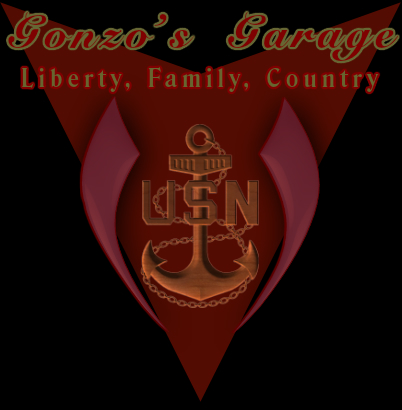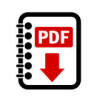 When you go through initial CERT training, you
are issued the standard helmet, a CERT vest, and a backpack
containing some basic tools and supplies. After you leave CERT
training, you will find that there are many more items that you
should have in your kit, and the basic backpack just isn't large
enough or sturdy enough to handle it all. And if you pack the basic
backpack full of "stuff," it is going to get heavy, and the backpack
just isn't sturdy enough (in my humble opinion) to contain all of
it.
When you go through initial CERT training, you
are issued the standard helmet, a CERT vest, and a backpack
containing some basic tools and supplies. After you leave CERT
training, you will find that there are many more items that you
should have in your kit, and the basic backpack just isn't large
enough or sturdy enough to handle it all. And if you pack the basic
backpack full of "stuff," it is going to get heavy, and the backpack
just isn't sturdy enough (in my humble opinion) to contain all of
it.
I prefer to take a more modular approach to my gear. This allows me
to distribute the contents and weight over a few different
containers. I just don't need every single piece of equipment on my
person at all times. There are certain tools and supplies that I do
need with me all the time, for example, but those things will fit
into a smaller tactical backpack. I put all my first-aid and medical
supplies into a pack all their own. And I use a larger pack to keep
things that I might need at the end of the day, or after a long
search and rescue.
This review will discuss all of these packs, their contents, and
some of the benefits that I have found from departing from the
standard issue CERT gear.
My CERT packs consist of essentially three packs:
A small tactical pack for carrying the gear I will need with me all
the time, a waist pack for medical and first-aid supplies, and a
larger pack for keeping such things as meals, extra clothes, rain
gear, hygiene supplies, and extra consumables for my medical kit and
the smaller CERT pack:
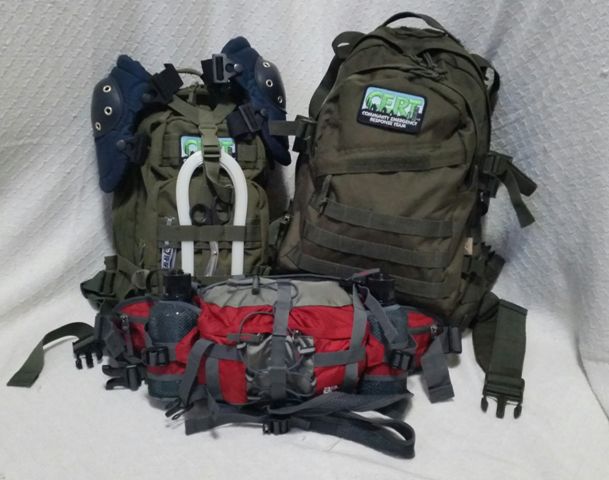
This is the standard issue CERT helmet, vest, and
backpack that I was issued when I went through my initial training.
The backpack has gotten better over the last few years, but they
still aren't as sturdy as I would like. I was issued a newer CERT
pack when I went through Instructor training, but the zippers broke
after a few times using the pack. I then transferred everything over
to one of my spare tactical packs. I also replaced the helmet, which
you can see in a separate review. And I purchased a more sturdy CERT
vest:

I'm big into packs with lots of MOLLE webbing,
because that allows me to easily attach things externally:

Here you see a few of my external attachments:
knife, trauma shears, and large zip ties. The large zip ties come in
handy for securing loose objects - they are very strong. Not shown
are some additional attachments such s a foldable camping saw,
walking pole, and trenching tool:
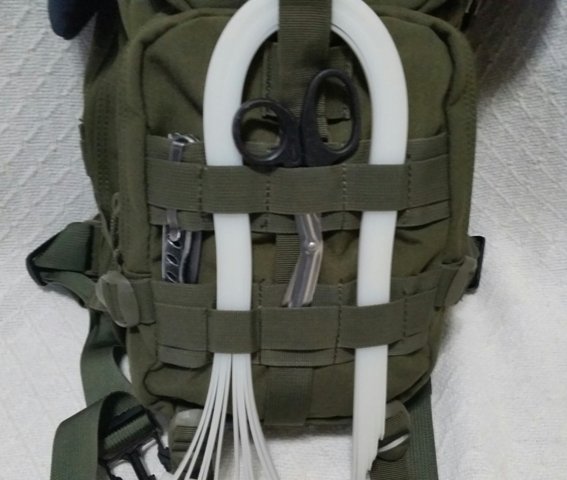
External attachments seen here are knee pads, a
large crescent wrench, "Figure-9" carabineers, and electrical tape.
The figure-9 carabineers are used for making attachment points to
use with rope or 550 Paracord. Electrical tape is used for just
about everything. That and duct tape are critical items to have in
your CERT pack:
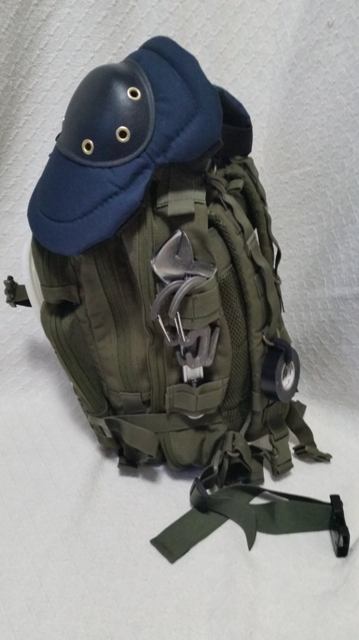
Contained in the smaller pouch on the front, at
the top, are a whistle, glass breaking/strap cutting tool, and
nitrile gloves. I carry several of the glass breaking/strap cutting
tools in my vehicle and elsewhere. These are specifically made for
breaking vehicle glass and cutting seat belts if you need to
extricate yourself or others from a burning vehicle or other similar
emergency situation:
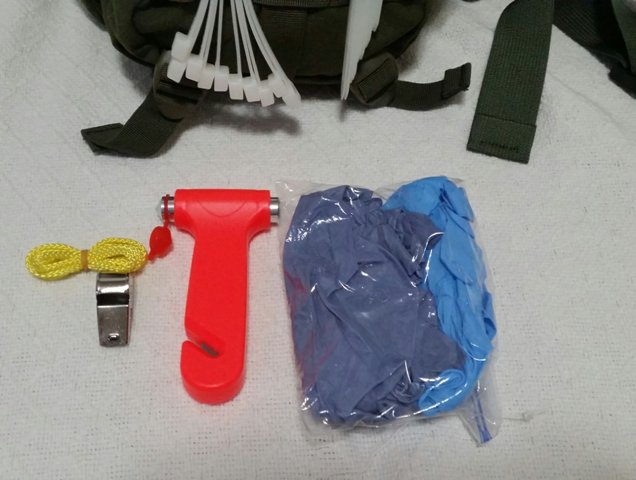
Next pocket down on the front of the pack, glow
sticks, Cliff Bars, the CERT Field Guide, and various water-proof
CERT booklets with forms and notepads to use for documenting a
scene. I carry lots of Sharpies, and also a waterproof pen to use
with the waterproof notepads. Small, hi-energy snacks, such as Cliff
Bars, are a necessity:
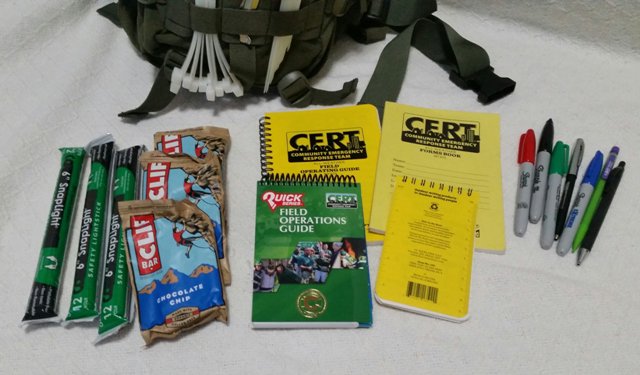
Larger compartment in the middle of the pack:
water, "Mechanix" gloves (I would actually be wearing these most of
the time), lumber pencils (for marking buildings that are being
searched), more glow sticks, N95 respirators, 5-Hour Energy drinks,
headlight, and an "Ambu" CPR face mask. As you will see, I carry
lots of water. The 5-Hour Energy drinks are good to keep your energy
up, but also have first-aid uses, such as if you come upon someone
with asthma, and they don't have their inhaler with them, caffeine
will help ease the distress caused my the asthma:
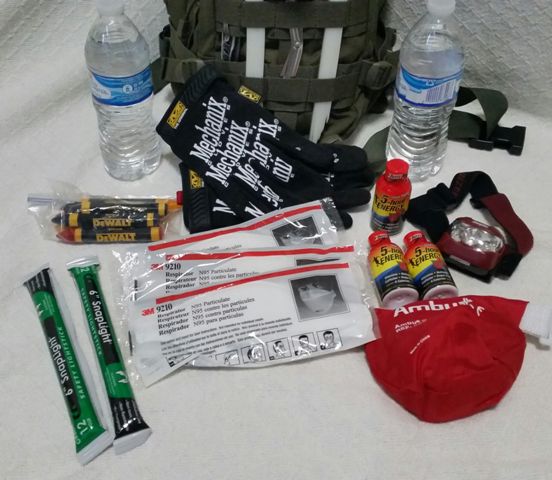
In the largest compartment of the pack, I carry a
poncho, extra zip ties, an emergency blanket, a casualty blanket,
another large emergency blanket, spark-proof utility tool, work
gloves, more nitrile gloves, an extra SWAT-T tourniquet, bandana,
and 50 feet of 550 paracord:
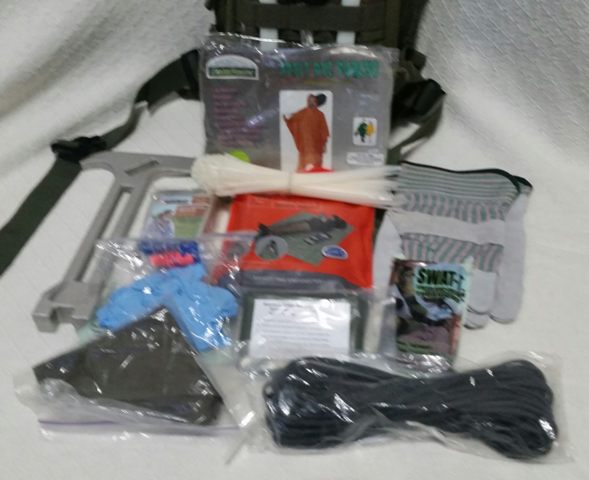
These two packs are what I would have with me at
all times, especially in a search and rescue situation. But again,
the beauty of going "modular" is that you can take off part of your
gear, and only carry what is needed at that particular time:
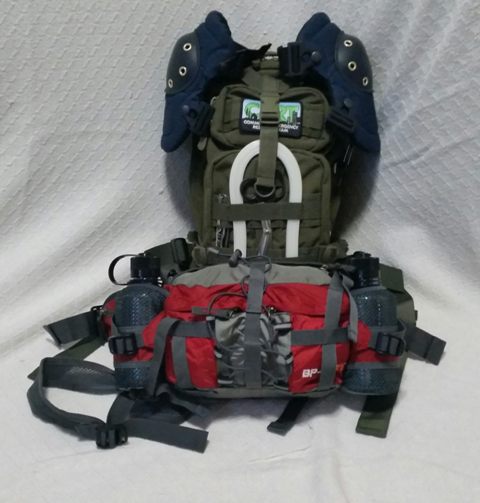
The waist pack is used exclusively for carrying
first-aid and medical supplies. I took a standard first-aid kit, and
added to it some Quik-Clot, a SWAT-T tourniquet, Israeli Bandages,
and some liquid glucose - good to have if you encounter a diabetic
who is in distress, and needs to have sugar quickly:
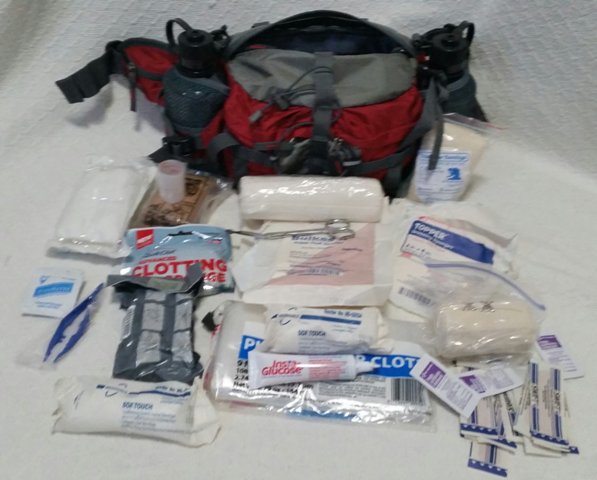
Notice more water containers. You need water for
yourself to stay hydrated. But it is also helpful to have water in a
pour-able container for irrigating wounds. The reason I mention that
is that some team members will carry all their water in a Camel-Back
container. Good for keeping hydrated, but hard to use in a situation
where you need to pour water on a wound or to flush out eyes. But
remember - water weighs about 8-pounds per gallon. Carrying too much
will weigh you down!
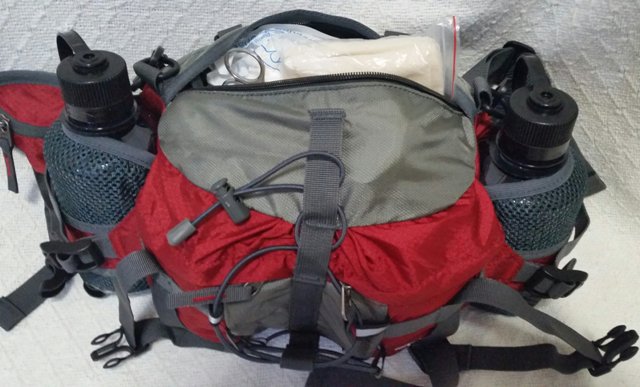
Last but not least - the large pack. This is my "basecamp
in a bag." I keep things that I do not need to have with me all the
time, but that I will definitely need at some point. Extra clothes,
freeze-dried meals, MREs, extra consumables (such as first-aid
equipment , glow sticks, N95 masks, etc), hygiene supplies (foot
powder, soap, hand sanitizer, toothbrush, etc). Oh, and EXTRA SOCKS!
After being on your feet all day, a change of socks will be quite
possibly the most regenerative thing you can do for yourself. I was
on an all-day land navigation training event one time - after 8
hours of hiking through mountainous terrain, a change of socks was a
life saver! This bag will probably be big and heavy. But then again,
you won't be carrying it around with you all day. This one just
provides a "container" for all this stuff, and can probably be left
in your vehicle while you're out doing other CERT duties:

Drop leg pouches
also make a nice addition to a modular equipment design. The pouch
on the left is a Condor Drop Leg Dump Pouch. It is a fairly large
pouch with a single compartment. It comes configured for left leg
wear, but the leg strap is reversible for wearing on the right leg.
This one makes a nice pouch for keeping things that you need
quickly, such as gloves, bandanas, masks, snacks, or other items
that you need to stow for a few moments, then retrieve again
quickly. The pouch on the right has two main compartments and two
magazine pouches. I can use the magazine pouches for a flashlight
and a knife. The largest of the two main compartments is the perfect
size for my Firefield Tracker 1x24 Night Vision Goggle Binoculars.
In the smaller main pouch on the front, I keep my laser range
finders. This is a VooDoo Tactical pouch that in and of itself is
not a drop-leg pouch. But it has MOLLE attachments, and easily
attaches to a VooDoo Tactical 20-0129001000 Mesh Drop Leg Platform:
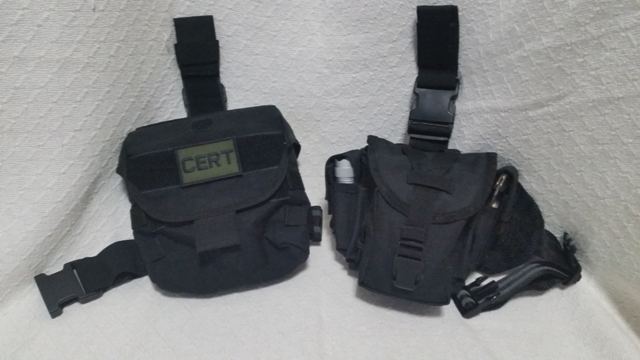
This is the original issue CERT vest I received when I first went
through training. It is extremely flimsy, does not have very
many sturdy pockets or gear attach points, and quite frankly smells
like formaldehyde! Many of the students complained about the
vests. The newer issue vests are much improved, but still
could be better.
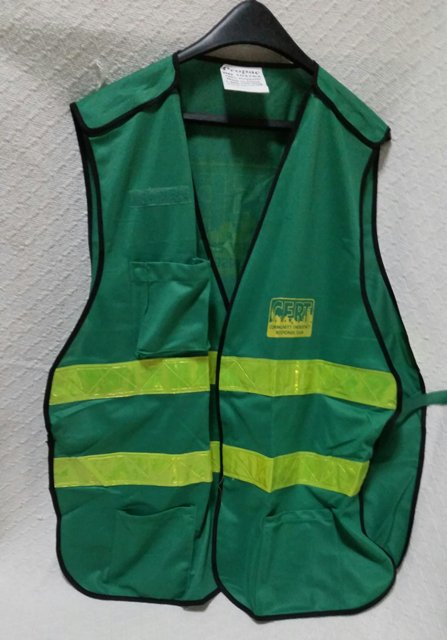
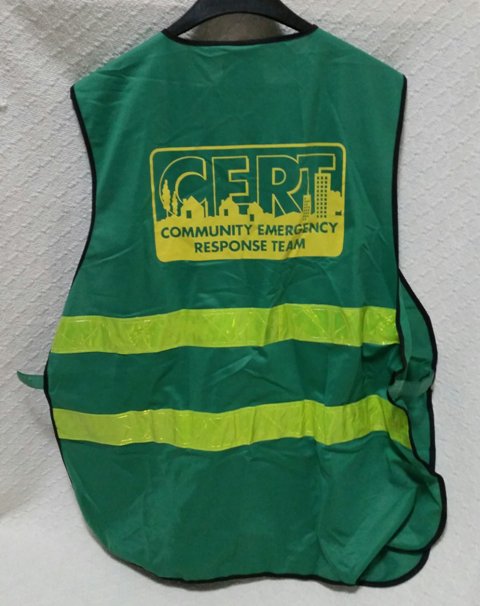
This is my new CERT vest. There are many available on Amazon
for very reasonable prices. This vest has many more pockets
and gear attach points, a credential holder, the weave is much
tighter and thicker, and it doesn't smell.
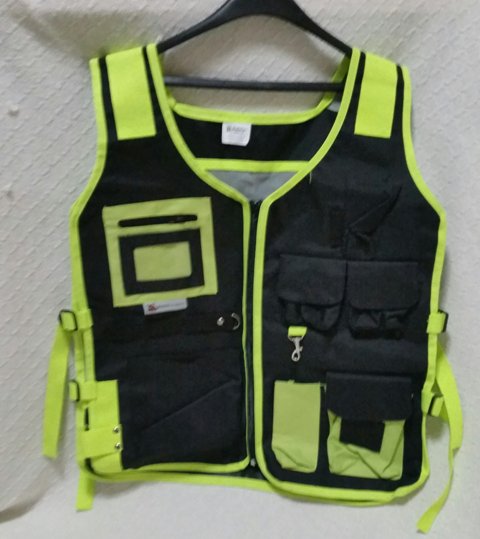
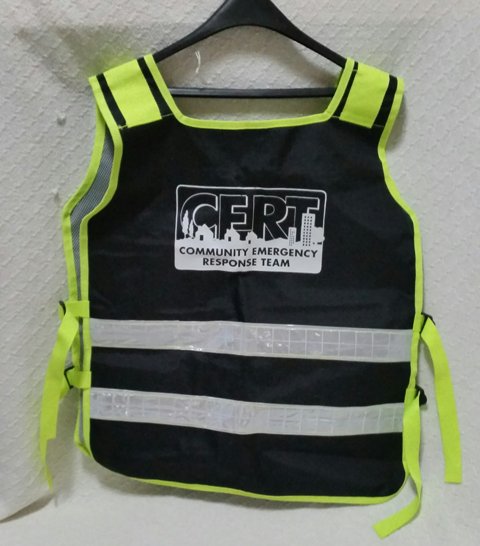
Additional things that I carry in my vehicle that
are too large to put into any of these CERT bags:
-
At least 7 gallons of water
-
Sleeping bag
-
Additional "Go Bags" with other survival
equipment, such as heat sources, additional food, etc
-
Tents and sleeping cots
-
Camping chairs
Download This Article as a PDF Document

